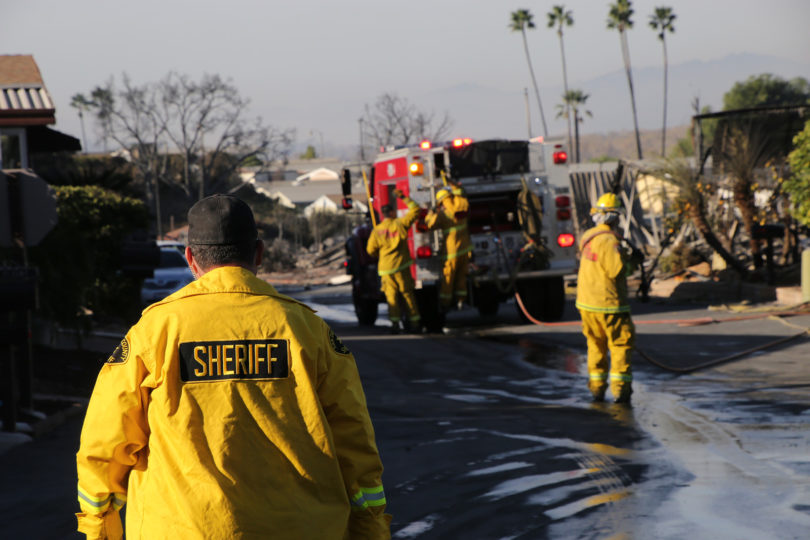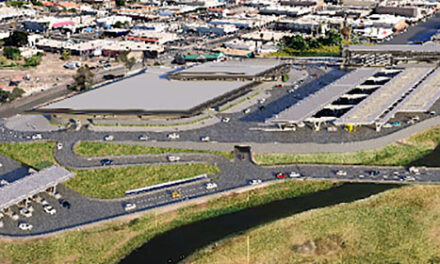
First responders perform rescue missions during last December’s Lilac fire in North County. Courtesy photo: County of San Diego
SAN DIEGO–Preparedness, regional collaboration, and fire and emergency management resources, coupled with a lucky break in the weather, were credited in a County After Action Report for stopping the December 2017 Lilac Fire’s fast-moving destructive path within 12 hours.
The report released Friday also credits heroic actions of first responders for saving lives in dangerous conditions.
“The County has invested a lot of resources in fire protection and preparedness and I think that paid off when you look at the regional response to the Lilac Fire,” said Supervisor Bill Horn. “The coordination between our city, state and federal partner agencies was incredible, as was the support of community organizations and the generosity of our residents.”
After action reports are generally completed after a local emergency as a way to document and evaluate an agency’s response. The Lilac Fire After Action Report documents a largely successful effort amid historically dangerous Santa Ana conditions. It also includes a number of recommendations to inform future responses.
The 4,100-acre fire started at 11:15 a.m. on Dec 7, just west of Interstate 15 and south of Highway 76 in severe dry, windy Santa Ana conditions. Two people, horse trainers, suffered serious burns while trying to help hundreds of animals at the San Luis Rey Downs horse training facility. More than 45 horses died in the first hours of the fire. Fire officials stated the Lilac Fire had the potential to burn more than a thousand homes. Ultimately, it burned 114 homes and damaged 55 structures. The cause of the fire remains under investigation.
The County estimates its costs for the aggressive fire and emergency management response is $5 million, which is expected to be offset with reimbursement from state and federal agencies. Cities and state agencies incurred additional costs for their efforts.
Since 2003, the County’s Board of Supervisors has invested more than $460 million on local firefighter equipment and capabilities to include a fleet of locally available firefighting aircraft. In the days prior to the Lilac Fire, as part of preparation prompted by the forecast of extreme fire danger, CAL FIRE and County Fire Authority instituted peak staffing and also worked together to mobilize a Type 1 Air-crane helicopter regional resource and coordinated with military aircraft for firefighting. During the fire, 22 helicopters and 11 fixed-wing aircraft helped put the fire out.
The preparation also included activating the Emergency Operations Center in Kearny Mesa the day before the fire to monitor for fires and coordinate with responding local and state departments and agencies including the San Diego County Office of Emergency Services, San Diego County Sheriff’s Department, 2-1-1, the American Red Cross, the Department of Animal Services, the County Communications Office, and the Department of Public Works. The proactive steps allowed the County to respond immediately when the fire broke out.
Within the first few hours, the Office of Emergency Services used the federal Wireless Emergency Alert system for the first time to warn residents of the dangerous fire on millions of enabled cellphones in the county.
The Sheriff’s Department and City of Oceanside issued evacuation notices using the County’s AlertSanDiego mass calling system. More than 44,000 households were notified. More than 1,300 of those were evacuated to American Red Cross shelters in El Cajon, Escondido, Oceanside or San Marcos, or the City of Carlsbad shelter.
Among the harrowing calls was a 90-year-old woman who needed help evacuating when her home caught fire. A responding CAL FIRE/San Diego County Fire crew and a Sheriff’s deputy were met by a locked iron gate which they had to remove. The fire engine raced up to the burning home and rescued the woman on the verge of collapse in her driveway and the deputy took her to safety. In another call, a CAL FIRE/San Diego County Fire engine, which had recently been upgraded to paramedic and Advanced Life Support capabilities, was requested to assist in treating one of the horse trainers who had suffered burns until he could be transported to a hospital.
The Del Mar Fairgrounds opened as a large animal shelter with more than 850 horses stabled there as a result. The Department of Animal Services evacuated 34 animals, assisted with 170 calls for help and cared for 263 animals that remained in the evacuated zone.
The public was informed through the SD Emergency app, the SDCountyEmergency.com website, social media, and the local media. The County’s Spanish translation team provided Spanish updates and a Partner Relay Network linked to community partners to translate information in eight other languages.
Before the fire’s containment on Dec. 13, the County opened a Local Assistance Center for affected residents at the Vista Library to help with immediate needs and information about the recovery process. More than 269 households were served. The County’s Department of Environmental Health later helped residents remove 14,500 pounds of hazardous waste and debris.
County recovery case managers continue to work with residents in the rebuilding process.
Among the recommended items for improvement include: Health and Human Services GIS staff join the Emergency Operations Center team in future incidents to help with a quick analysis of health-related services such as hospitals and skilled nursing facilities within the disaster zone; identify additional large animal shelters for horses and livestock in the event that the Del Mar Fairgrounds has reached capacity or is unavailable due to a fair event, and in response to activating the WEA system, it was recommended that the County use this system only when it’s the most appropriate tool as was the case in the Lilac Fire when emergency officials need to quickly alert as many people as possible in a disaster area. The County will also continue to advocate for federal lawmakers overseeing the WEA system to make improvements such as hyperlinks, maps and additional text characters for more informative alerts.




